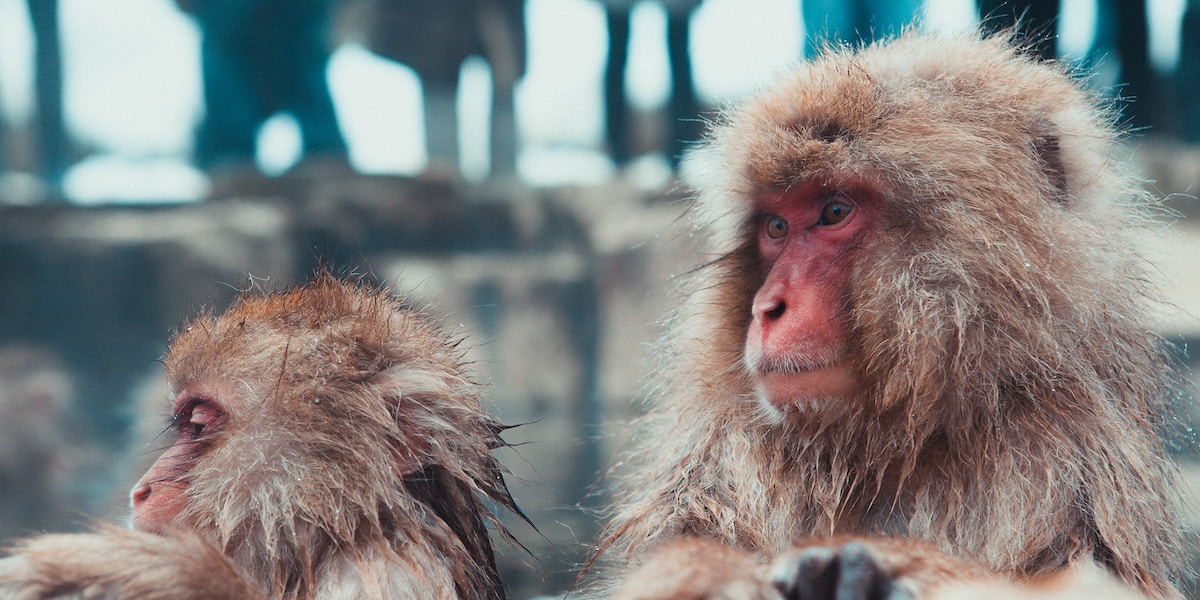
Adolf Hitler, who ordered the execution of some eight million people and was responsible for the deaths of many millions more, was said by his secretary Traudl Junge to have had an agreeable, friendly, and paternal manner. He hated cruelty to animals: he was a vegetarian, adored his dog Blondi and was inconsolable when Blondi died.
Pol Pot, the leader of Cambodia whose policies killed maybe a quarter of his country’s people, was known to his acquaintances as a soft-spoken and kindly teacher of French history.
During eighteen months in prison, Joseph Stalin was always amazingly calm and never shouted or swore. In effect, he was a model gentleman-inmate, not obviously the kind of person who would later annihilate millions for political convenience.
Because seriously evil men can have a gentle side, we hesitate to empathize with their kindness for fear of seeming to rationalize or excuse their crimes. Such men remind us, however, of a curious fact about our species. We are not merely the most intelligent of animals. We also have a rare and perplexing combination of moral tendencies. We can be the nastiest of species and also the nicest.
In 1958, the playwright and songwriter Noël Coward captured the strangeness of this duality. He had lived through the Second World War, and the bad side of human nature was fully obvious to him. “It is hard to imagine,” he wrote, “considering the inherent silliness, cruelty and superstition of the human race, how it has contrived to last as long as it has. The witch-hunting, the torturing, the gullibility, the massacres, the intolerance, the wild futility of human behaviour over the centuries is hardly credible.”
And yet most of the time we do wonderful things that are the very opposite of “silliness, cruelty and superstition,” depending as they do on reason, kindness, and cooperation. The technological and cultural marvels that distinguish our species are made possible by these qualities, in combination with our intelligence. Coward’s examples still resonate.
Trending: 5 Reasons Life Gets Better After Your 40s
Hearts can be withdrawn from human breasts, dead hearts, and, after a little neat manipulation, popped back again as good as new. The skies can be conquered. Sputniks can whizz round and round the globe and be controlled and guided . . . and My Fair Lady opened in London last night.
Heart surgery, space travel, and comic opera all depend on advances that would have amazed our distant ancestors. More important from an evolutionary point of view, however, they also depend on capacities for a quite exceptional ability to work together, including tolerance, trust, and understanding. Those are some of the qualities that cause our species to be thought of as exceptionally “good.”
“The potential for good and evil occurs in every individual.”
In short, a great oddity about humanity is our moral range, from unspeakable viciousness to heartbreaking generosity. From a biological perspective, such diversity presents an unsolved problem. If we evolved to be good, why are we also so vile? Or if we evolved to be wicked, how come we can also be so benign?
The combination of human good and evil is not a product of modernity. To judge from the behavior of recent hunter-gatherers and the records of archaeology, for hundreds of thousands of years people have shared food, divided their labor, and helped the needy. Our Pleistocene ancestors were in many ways thoroughly tolerant and peaceful. Yet the same sources of evidence also indicate that our forebears practiced raiding, sexual dominance, torture, and executions with varieties of cruelty that were as abominable as any Nazi practice. Certainly nowadays, a capacity for great cruelty and violence is not particular to any one group. For a variety of reasons, a given society might have experienced exceptional peace for decades even as another might have suffered spasms of exceptional violence. But this does not suggest any differences in the innate psychology of people throughout time and world over. Everywhere humans seem to have had the same propensity for both virtue and violence.
Babies show a similar contradiction in their tendencies. Before infants can talk, they will smile and chuckle and sometimes help a friendly adult in need, an extraordinary demonstration of our innate predisposition to trust one another. At other times, however, those same bighearted offspring will scream and rage with sublime self-centeredness to get their way.
There are two classic explanations for this paradoxical combination of selflessness and selfishness. Both assume that our social behavior is hugely determined by our biology. Both also agree that only one of our two notable tendencies is the product of genetic evolution. They differ, however, in which side of our personality each regards as fundamental—our docility, or our aggressiveness.
One explanation posits that tolerance and docility are innate to humanity. According to this view, although we are essentially good, our corruptibility stands in the way of our living in perpetual peace. Some religious thinkers blame supernatural forces such as the devil or “original sin” for this state of affairs. Secular thinkers, by contrast, might choose instead to imagine evil as engendered by societal forces such as patriarchy, imperialism, or inequality. Either way, it is assumed that we are born good but are susceptible to corruption.
The other explanation claims that it is our bad side that is innate. We are born selfish and competitive, and we would continue in the same vein were it not for efforts at self-improvement informed by civilizing forces, which might include enjoinments from parents, philosophers, priests, and teachers, or the lessons of history.
For centuries, people have simplified their understanding of a confusing world by adopting one or the other of these opposed views. Jean-Jacques Rousseau and Thomas Hobbes are classic icons for the alternatives. Rousseau has come to stand for humanity’s being instinctively nice, Hobbes for humanity’s being naturally wicked.

Both positions have some merit. There is plenty of evidence that humans have innate tendencies for kindness, just as there is for our having spontaneously selfish feelings that can lead to aggression. No one has found a way to say that one kind of tendency is more biologically meaningful or evolutionarily influential than the other.
The intrusion of politics makes the debate all the harder to settle, because when these abstractly theoretical analyses become arguments with societal significance, both sides tend to harden their stance. If you are a Rousseauian, your belief in essential human goodness probably marks you out as a peace-loving, easygoing crusader for social justice with faith in the masses. If you are a Hobbesian, your cynical view of human motives suggests you see a need for social control, cherishing hierarchy and accepting the inevitability of war. The debate becomes less about biology or psychology and more about social causes, political structures, and the moral high ground. Prospects for simple resolution duly recede.
I believe that there is an escape from this morass about the fundamental nature of humans. Rather than needing to prove that either side is wrong, we should ask whether the debate makes sense at all. Babies point us in the right direction: the Rousseau and Hobbes perspectives were both right as far as they went. We are naturally good in the way that Rousseau is said to have claimed, and we are naturally selfish, much as Hobbes argued. The potential for good and evil occurs in every individual. Our biology determines the contradictory aspects of our personalities, and society modifies both tendencies. Our goodness can be intensified or corrupted, just as our selfishness can be exaggerated or reduced.
Once we acknowledge that we are at once innately good and innately bad, the sterile old argument gives way to fascinating new problems. If Rousseauians and Hobbesians are both partly right, then what is the source of our strange combination of behavioral tendencies? We know from the study of other species, particularly birds and mammals, that natural selection can favor a wide range of inclinations. Some species are relatively uncompetitive, some relatively aggressive, some both, some neither. The combination that makes humans odd is that we are both intensely calm in our normal social interactions, and yet in some circumstances so aggressive that we readily kill. How did this come to be?
Evolutionary biologists follow a principle crisply stated by the geneticist Theodosius Dobzhansky in a 1973 address to the National Association of Biology Teachers: “Nothing in biology makes sense except in the light of evolution.” How evolutionary theory is best used, however, is a subject of debate. A key question for this book is: what is the significance of primate behavior?
A traditional view holds that animal and human mentality differ so widely that primates are irrelevant for the science of human nature. Thomas Henry Huxley was the first evolutionary biologist to challenge that position. In 1863 he argued that apes provide rich clues to the origins of human behavior and cognition: “I have endeavoured to show that no absolute structural line of demarcation . . . can be drawn between the animal world and ourselves.” Huxley anticipated his opponents’ objections. “On all sides I shall hear the cry—‘The power of knowledge—the conscience of good and evil—the pitiful tenderness of human affections, raise us out of all real fellowship with the brutes.’” That kind of skepticism is understandable and has not completely disappeared. In 2003, the evolutionary biologist David Barash argued “it is highly questionable whether human beings carry a significant primate legacy at all when it comes to behavior.”
“We are naturally good in the way that Rousseau is said to have claimed, and we are naturally selfish, much as Hobbes argued.”
There are also variations of behavior galore due to culture. One society is peaceful, another violent. One reckons clan membership down the female line, one down the male line. Some have strict rules about sexual behavior, while others are lax. The diversity can seem so overwhelming as to render uniformity irrelevant for comparison with other species. After a detailed survey of hunter-gatherer behavior, the anthropologist Robert Kelly abandoned the notion that human behavior can be characterized as having any particular form. “There is no original human society, no basal human adaptation,” he wrote in 1995. “Universal behaviors . . . never existed.”
In short, the idea that human behavior is so infinitely variable that our species has no special features in common with nonhuman primates is understandable. Two strong arguments stand against it, however.
Trending: 40 Nonfiction Books to Look Out for in 2024
On the one hand, human variation is limited. We really do have characteristic forms of society. Nowhere do people live in troops, as baboons do, or in isolated harems, like gorillas, or in entirely promiscuous communities, like chimpanzees or bonobos. Human societies consist of families within groups that are part of larger communities, an arrangement that is characteristic of our species and distinctive from other species.
Yet, on the other hand, in many ways humans and primates really do behave alike. The evolutionist Charles Darwin early on observed similarities in the expressions of emotion in humans and other animals, such as the “bristling of the hair under the influence of extreme terror” or “uncovering of the teeth under [the influence] of extreme rage.” This “community of certain expressions,” he wrote, is “rendered somewhat more intelligible if we believe in their descent from a common ancestor.”
The fact that we share smiles and frowns with our cousin primates is intriguing, but even that observation seems relatively trivial compared with the discoveries about chimpanzee and bonobo behavior that began in the 1960s, and continue to accumulate. Chimpanzees and bonobos are the two ape species most closely, and equally, related to humans. They present an astonishing pair. They look so similar to each other that they were not recognized to be separate species for years after both were known. Each of the two sister species shares extensive behavioral similarities to humans. Yet they are in many ways social opposites.
Among chimpanzees, males are dominant over females, and they are relatively violent. Among bonobos, females are often dominant over males, violence is muted, and eroticism is a frequent substitute for aggression. The behavioral distinctions between the two eerily echo competing social stances in the modern human world: the divergence of male and female interests, for example; or between hierarchy, competition, and power on the one hand, and egalitarianism, tolerance, and negotiated settlement on the other. The two species conjure such different visions of the essential ape that their opposition has become something of a battleground in primatology, each supposed by different schools to represent our ancestral lineage better than the other. As we will see, the notion that either chimpanzees or bonobos, but not both, point to human behavioral origins is not very helpful. A more intriguing goal is to understand why the two species are similar to humans in their different ways. Their behavioral contrasts are of a piece with the central question animating this book: why are humans both highly tolerant, like bonobos, and highly violent, like chimpanzees?

From THE GOODNESS PARADOX by Richard Wrangham. Copyright © 2019 by Richard Wrangham. Reprinted by permission of Pantheon Books, an imprint of the Knopf Doubleday Publishing Group, a division of Penguin Random House LLC.
Ready for more big ideas like this? Join the Next Big Idea Club today!































